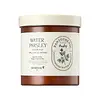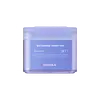What's inside
What's inside
 Key Ingredients
Key Ingredients

 Benefits
Benefits

 Concerns
Concerns

 Ingredients Side-by-side
Ingredients Side-by-side

Water
Skin ConditioningOenanthe Javanica Extract
AntimicrobialButylene Glycol
Humectant1,2-Hexanediol
Skin ConditioningDipropylene Glycol
HumectantCitrus Junos Fruit Extract
Skin ConditioningPanthenol
Skin ConditioningPPG-13-Decyltetradeceth-24
EmulsifyingBetaine
HumectantEthylhexylglycerin
Skin ConditioningFicus Carica Fruit Extract
HumectantAllantoin
Skin ConditioningGlycerin
HumectantPropanediol
SolventDiphenyl Dimethicone
EmollientTriethylhexanoin
MaskingCapryloyl Salicylic Acid
ExfoliatingCentella Asiatica Extract
CleansingSodium Citrate
BufferingSalvia Officinalis Leaf Extract
CleansingChamomilla Recutita Extract
Skin ConditioningDipotassium Glycyrrhizate
HumectantSodium Phytate
Polyglyceryl-10 Oleate
Skin ConditioningHydrogenated Lecithin
EmulsifyingSodium Hyaluronate
HumectantPhospholipids
Skin ConditioningRhodomyrtus Tomentosa Fruit Extract
HumectantEucalyptus Globulus Leaf Oil
PerfumingLeuconostoc/Radish Root Ferment Filtrate
AntimicrobialCitrus Aurantium Bergamia Fruit Oil
MaskingHelianthus Annuus Seed Oil
EmollientPantothenic Acid
Skin ConditioningSalvianolic Acid B
Skin ConditioningWater, Oenanthe Javanica Extract, Butylene Glycol, 1,2-Hexanediol, Dipropylene Glycol, Citrus Junos Fruit Extract, Panthenol, PPG-13-Decyltetradeceth-24, Betaine, Ethylhexylglycerin, Ficus Carica Fruit Extract, Allantoin, Glycerin, Propanediol, Diphenyl Dimethicone, Triethylhexanoin, Capryloyl Salicylic Acid, Centella Asiatica Extract, Sodium Citrate, Salvia Officinalis Leaf Extract, Chamomilla Recutita Extract, Dipotassium Glycyrrhizate, Sodium Phytate, Polyglyceryl-10 Oleate, Hydrogenated Lecithin, Sodium Hyaluronate, Phospholipids, Rhodomyrtus Tomentosa Fruit Extract, Eucalyptus Globulus Leaf Oil, Leuconostoc/Radish Root Ferment Filtrate, Citrus Aurantium Bergamia Fruit Oil, Helianthus Annuus Seed Oil, Pantothenic Acid, Salvianolic Acid B
Water
Skin ConditioningDipropylene Glycol
Humectant1,2-Hexanediol
Skin ConditioningBetaine
HumectantSodium PCA
HumectantHydroxyacetophenone
AntioxidantOctyldodeceth-16
EmulsifyingHydroxyethyl Urea
HumectantDipotassium Glycyrrhizate
HumectantSodium Citrate
BufferingAllantoin
Skin ConditioningXanthan Gum
EmulsifyingHydroxyethylcellulose
Emulsion StabilisingCitric Acid
BufferingDisodium EDTA
Olea Europaea Fruit Oil
MaskingGlycerin
HumectantSea Water
HumectantMyosotis Sylvatica Flower/Leaf/Stem Extract
Skin ConditioningButylene Glycol
HumectantPolyglyceryl-10 Laurate
Skin ConditioningAbies Sibirica Oil
MaskingHydrogenated Lecithin
EmulsifyingRosmarinus Officinalis Leaf Oil
MaskingPseudoalteromonas Ferment Extract
HumectantSalvia Sclarea Oil
MaskingCetraria Islandica Extract
CleansingMentha Aquatica Extract
TonicAnthemis Nobilis Flower Oil
MaskingJuniperus Mexicana Oil
MaskingChamomilla Recutita Flower Oil
MaskingMangifera Indica Fruit Extract
Skin ConditioningLactobacillus Ferment
Skin ConditioningCaprylyl Glycol
EmollientWater, Dipropylene Glycol, 1,2-Hexanediol, Betaine, Sodium PCA, Hydroxyacetophenone, Octyldodeceth-16, Hydroxyethyl Urea, Dipotassium Glycyrrhizate, Sodium Citrate, Allantoin, Xanthan Gum, Hydroxyethylcellulose, Citric Acid, Disodium EDTA, Olea Europaea Fruit Oil, Glycerin, Sea Water, Myosotis Sylvatica Flower/Leaf/Stem Extract, Butylene Glycol, Polyglyceryl-10 Laurate, Abies Sibirica Oil, Hydrogenated Lecithin, Rosmarinus Officinalis Leaf Oil, Pseudoalteromonas Ferment Extract, Salvia Sclarea Oil, Cetraria Islandica Extract, Mentha Aquatica Extract, Anthemis Nobilis Flower Oil, Juniperus Mexicana Oil, Chamomilla Recutita Flower Oil, Mangifera Indica Fruit Extract, Lactobacillus Ferment, Caprylyl Glycol
 Reviews
Reviews

Ingredients Explained
These ingredients are found in both products.
Ingredients higher up in an ingredient list are typically present in a larger amount.
1,2-Hexanediol is a synthetic liquid and another multi-functional powerhouse.
It is a:
- Humectant, drawing moisture into the skin
- Emollient, helping to soften skin
- Solvent, dispersing and stabilizing formulas
- Preservative booster, enhancing the antimicrobial activity of other preservatives
Allantoin is a soothing ingredient known for its protective and moisturizingg properties. Because of this, it is often added to products with strong active ingredients.
Studies show higher concentrations of this ingredient can promote wound healing.
Though it can be derived from the comfrey plant, allantoin is produced synthetically for cosmetic products to ensure purity.
Learn more about AllantoinBetaine is a common humectant (a substance that promotes retention of moisture). It's known to be gentle on the skin and can help balance hydration.
This ingredient is best for improving hydration and soothing irritated skin. Studies also show it helps even out skin tone.
Fun fact: Betaine is naturally created in the skin and body. The kind found within cosmetic products can be either plant-derived or synthetic.
Another name for betaine is trimethylglycine.
Learn more about BetaineButylene Glycol (or BG) is used within cosmetic products for a few different reasons:
Overall, Butylene Glycol is a safe and well-rounded ingredient that works well with other ingredients.
Though this ingredient works well with most skin types, some people with sensitive skin may experience a reaction such as allergic rashes, closed comedones, or itchiness.
Learn more about Butylene GlycolDipotassium Glycyrrhizate comes from licorice root.
Extracts of licorice have demonstrated to have antibacterial, anti‐inflammatory, antiviral, antioxidant properties.
One component, glabridin, has extra potent antioxidant and soothing properties. It has also been found to block pigmentation from UVB rays in guinea pigs.
Licorice Root also contains a flavonoid. Flavonoids are a natural substance from in plants. Flavonoids also have antioxidant properties.
Another component, glycyrrhizin, has been found to have anti-inflammatory and antimicrobial benefits. This may make licorice root extract effective at treating acne. However, more research is needed to support this.
Liquiritin is one of the flavone compounds found in licorice. It has been found to help lighten skin by preventing tyrosinase from reacting with tyrosine. When the two react, protein is converted to melanin. Melanin is the substance in your body that gives your features pigmentation.
Licorice root is native to Southern Europe and Asia. It has been used in traditional Chinese medicine to help with respiratory issues.
Learn more about Dipotassium GlycyrrhizateDipropylene Glycol is a synthetically created humectant, stabilizer, and solvent.
This ingredient helps:
Dipropylene glycol is technically an alcohol, but it belongs to the glycol family (often considered part of the ‘good’ alcohols). This means it is hydrating and gentle on skin unlike drying solvent alcohols like denatured alcohol.
As a masking agent, Dipropylene Glycol can be used to cover the smell of other ingredients. However, it does not have a scent.
Studies show Dipropylene Glycol is considered safe to use in skincare.
Learn more about Dipropylene GlycolGlycerin is already naturally found in your skin. It helps moisturize and protect your skin.
A study from 2016 found glycerin to be more effective as a humectant than AHAs and hyaluronic acid.
As a humectant, it helps the skin stay hydrated by pulling moisture to your skin. The low molecular weight of glycerin allows it to pull moisture into the deeper layers of your skin.
Hydrated skin improves your skin barrier; Your skin barrier helps protect against irritants and bacteria.
Glycerin has also been found to have antimicrobial and antiviral properties. Due to these properties, glycerin is often used in wound and burn treatments.
In cosmetics, glycerin is usually derived from plants such as soybean or palm. However, it can also be sourced from animals, such as tallow or animal fat.
This ingredient is organic, colorless, odorless, and non-toxic.
Glycerin is the name for this ingredient in American English. British English uses Glycerol/Glycerine.
Learn more about GlycerinHydrogenated Lecithin is created from the hydrogenation of lecithin (a group of phospholipids). Hydrogenation is a chemical reaction between hydrogen and another element.
This ingredient is an emollient and emulsifier. As an emollient, it helps soften skin by trapping moisture within. As an emulsifier, it prevents oil and water ingredients from separating.
Sodium Citrate is the sodium salts of citric acid. In skincare, it is used to alter pH levels and acts as a preservative.
Its main functions are to maintain the pH of a product and neutralize metal ions.
The acidity of our skin is maintained by our glands and skin biome; normal pH level of skin is slightly acidic (~4.75-5.5).
Being slightly acidic allows our skin to create an "acid mantle". This acid mantle is a thin barrier that protects our skin from bacteria and contaminants.
Learn more about Sodium CitrateWater. It's the most common cosmetic ingredient of all. You'll usually see it at the top of ingredient lists, meaning that it makes up the largest part of the product.
So why is it so popular? Water most often acts as a solvent - this means that it helps dissolve other ingredients into the formulation.
You'll also recognize water as that liquid we all need to stay alive. If you see this, drink a glass of water. Stay hydrated!
Learn more about Water